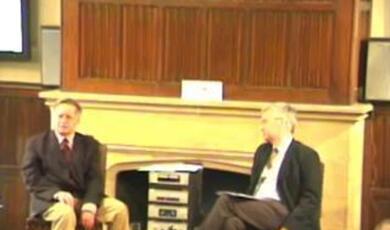Mazurkas and Christmas Lullabies
Share
- Details
- Text
- Audio
- Downloads
- Extra Reading
The tradition of the East-Central European carol is long and distinguished, if barely appreciated elsewhere. What are its characteristics, its relationships to different religious denominations, folk cultures and poetry?
Download Text
MAZURKAS AND CHRISTMAS LULLABIES Professor Adrian Thomas 1. Introduction Good afternoon, and welcome to the third of this year's music lectures at Gresham College under the title,'Music in History - Music before Chopin'. Given the fact that last Sunday was Advent Sunday and that Christmas itself is fast approaching, I thought that it might be both interesting and fun to look at the role music plays at this time of year in Eastern Europe, and specifically in Poland. This talk actually transgresses the title'Music before Chopin', not least because, although much of the music that you'll hear today was around before Chopin's time, it is still very much alive today. We will be hearing music from the Renaissance, from Chopin, music from today's carol repertoire (drawn mainly from the 17th and 18th centuries, the'golden age' of the Polish carol), and fascinating examples of carols from folk traditions. And I'm keen to play you as much music as possible! As I began to prepare for today, I had to ask myself what I consciously knew about the genre of the carol. Like many of you, I'm familiar with some examples of the equivalent genres in France - the noel - and in Germany - the Weinachtslied. Take this familiar tune, with words in their original language. MUSIC Les anges dans nos campagnes When we look into the origins of a whole host of carols, we find that, while there are some very distinctive British ones, we are witness to the universal appeal of carols not only from France like that one (also Ding dong! Merrily on high) and German-speaking countries (Quem pastores laudavere, As with gladness men of old, Silent Night, Mendelssohn's tune for Hark! The herald angels sing) but also from further afield, such as America (Away in a manger, O little town of Bethlehem ). And this surely is a major strengthening of Christian as well as musical ties across nationalities. But how many carols do we know from Rumania, or Hungary, the Czech Republic or Poland? Very few Czech koledy or Polish koledy, for example, have established themselves, for reasons which are historical as much as linguistic. There are a few that you will recognise, even though the substitute English texts differ from collection to collection. For example, here's arguably the Czech carol best known in this country as the Rocking Carol, although many of us are more familiar with the translation by Percy Dearmer: Little Jesus, sweetly sleep, do not stir; we will lend a coat of fur. And here's another Czech example, known as the Zither Carol. The characteristic feature here is its metric pattern which alternates three bars of 2/4 with two bars of 3/4, a pattern which relates to the Czech dance, the furiant. You can hear this in Dvorak's Sixth Symphony, for example, where a furiant takes the place of the scherzo. This is the moment for us to transport ourselves to Poland, where grand, tinselly or elaborate treatments of carols are much rarer than here (that version of Les Anges dans nos campagnes by the Ely Cathedral Choir is symptomatic of a strong trend in our own carrolling) and where we can marvel at and take new sustenance from a tradition that is foreign to us. MUSIC He lies in a manger (W zlobie lezy) In fact, that Polish carol is one of two that you may know already and which you can sometimes find on CD compilations. (It is also been published in the New Oxford Book of Carols.) It's called He lies in a manger (W zlobie lezy) and on that recording it was sung by Ely Cathedral Choir once again. From its early sentiment - "Who will hurry to sing carols for the Little One?", He lies in a manger develops into a pointed dialogue between mankind and Jesus, who is questioned on why he is in a manger and not in a bed, why he is prepared to be scorned by this world and to suffer'the bed of the cross'. In other words, it emphasises the traumas ahead. And yet its gentle rocking 3/4 metre, with its hints of both mazurka and polonaise, belies such stark images. He lies in a manger is interesting for another reason. It played a role in the musical life of the Polish royal court and was apparently played at the wedding of King Wladyslaw IV in the mid-17th century. The genre of the Polish carol (koleda) dates back to developments in medieval Latin liturgy, through substitutions of Latin by Polish texts, the metrical reshaping of chants, the development of polyphony, much as other vocal music from the medieval to Renaissance periods. 2. Renaissance There are some quite beautiful examples contemporary with He lies in a manger. Here are three with Polish texts, but whose authors and composers remain unknown. The first, dating from a Roman Catholic Kancional (hymn book) of 1586, This joyous day (Wesoly nam), is particularly delightful. It has just two four-bar phrases, and the opening lines say: This joyous day the Lord made for us, The Lord who as a human being appeared to the whole world" Its most distinctive feature is the lilting rhythm, a rhythm that in later centuries became synonymous with Christmas music, as symbolised by the famous pastorale at the end of Corelli's Christmas Concerto or the famous instrumental interlude in Part One of Handel's Messiah. MUSIC This joyous day (Wesoly nam) My second example, from a Protestant late 16th-century hymn book, also has a triple-time rhythm and a rather more extended structure. Its text reads: The angels sang, proclaiming great joy to the shepherds. Unheard-of joy: the Virgin gave birth to a Son. The Virgin gave birth, without losing her maidenhood. Let us offer glory and honour to God. Let us be happy and sing. MUSIC The angels sang (Aniolowie zaspiewali) My final Renaissance example of a Polish koleda is not in triple metre but a fast 4/4. Its almost madrigalian texture is built around a tenor line borrowed from elsewhere. In this performance the tenors intone their line alone and then present the text, with the other voices joining in as if imitating instruments. Despite its high level of musical sophistication, its text is directed towards the younger members of the family: Come on, children, let us sing merrily, That Christ the Lord is our Saviour. MUSIC Come on, children (Nuz my, dziatki) What those three carols demonstrate is the high quality of musical composition in late 16th-century Poland, an era to which I will return in more detail in my next lecture. 3. Popular Carols However, none of those three survives in today's popular repertoire in Poland. In making a selection from those carols popular today I was faced with the problem of how to measure popularity. So I enlisted the help of friends and friends of friends in Poland, ranging from children to grandparents. In my'poll of Poles' I received responses from 30 people, who not only listed their favourites, usually in order of preference, but also sometimes gave their reasons. I have drawn on some of these anonymous comments in what follows. To my surprise, He lies in a manger came in in only 15th= place (Silent night came in six places higher!). Top of the pops, with almost 90% of the vote, was this celebratory carol, God is born. Its melody dates from the late 18th or early 19th century. MUSIC God is born (Bog sie rodzi) My correspondents cited the lofty, noble melody of God is born, its imposing, ceremonial character. Much of this stems from the fact that it is a polonaise, the most stately of Polish dances. The polonaise emphasises not just the first beat but also the quavers that lead to the next down-beat (think of Chopin's examples). In joint second place was one of my own favourites, In the still of the night (Wsrod nocnej ciszy), again dating from the late 18th or early 19th century. This was described to me variously as maybe the best-known carol in Poland, joyful, optimistic and majestic. It also has a new feature, which will become apparent after the choir has recovered from an organ intro that's too fast (we've all been there before, haven't we!). MUSIC In the still of the night (Wsrod nocnej ciszy) What's interesting about In the still of the night is its bipartite structure, the prayerful opening followed by a more jaunty response. This type of structure, often with repeats, is not uncommon in Polish hymns, carols and songs. Here, it matches the developing story of the shepherds: first they're in the fields, the next moment they're hurrying to Bethlehem. As an example of a carol with the same theme but with even more urgency, we can do no better than turn to They hastened to Bethlehem (Przybiezeli do Betlejem). There's also a mention of them playing the hurdy-gurdy as they go along. There's no denying their lively pace! MUSIC They hastened to Bethlehem(Przybiezeli do Betlejem) Incidentally, you may have noticed how, at the opening, the basses entered in canon to the tune, a feature much loved by some of my Polish correspondents. And I'm also told that this carol is popular with those who perform it in folk-rock style! My last two carols from today's repertoire come a little lower down the chart, yet each of them brings a new dimension to the repertoire. The first of them is God is born (Gdy sie Chrystus rodzi), first found in a mid-19th-century hymn book. It too takes the story of the shepherds - this pastoral theme remains extremely strong in a country which is still largely rural - but couches it in a special way. The music is constructed in three phases: a gentle four-bar phrase, repeated, a faster four-bar phrase, and a final six-bar phrase not in the vernacular but in Latin: "Gloria, gloria, gloria, in excelsis Deo". MUSIC When God is born (Gdy sie Chrystus rodzi) Isn't that magnificent? The use of the two languages was not uncommon - macaronic verse had its place in Polish literature as in most other European countries, and we have that type of carol too, as we heard at the beginning - but that extension of the last phrase by the repetition of "Gloria" is a masterstroke. One correspondent relishes the rising tension of those repetitions. And, finally in this section, comes a modest little carol that packs an expressive punch. And with it we return to the dominant metre of the established Polish carol: 3/4. Shabby, quiet (Mizerna, cicha) belongs to a category of Polish koleda sometimes termed'salon' carol, because it was written with piano accompaniment in mind. This was part of a larger grouping known as the'home' carol (domowa) as distinct from carols based in church worship (although today, as here, the distinction is increasingly blurred). This domestic tradition is very much alive today, and it is still common for groups of friends or families to gather together several times between Advent and Christmas to sing carols, sometimes with a glass of wine to wet the throat! I don't have time today to go into details about Christmas traditions in Poland, but you should be aware that the main day of celebration is not on Christmas Day but on Christmas Eve, or Wigilia as it is called. That is the time for breaking of the Advent fast, for the family together to eat specially cooked fish dishes, traditionally carp, and to maintain their vigil for the birth of Jesus. In such circumstances, this nextlittle carol is a precious reminder of why they are celebrating Wigilia. Small wonder that my correspondents commented on its yearning melody and moving words, calling it fascinating, strange and even revolutionary. Its text, seemingly based on pictures and sculptures of the scene, reads: Shabby, quiet, a stable poor, Full of heavenly glory There lies, sleeping before us Little Jesus in rays of light. The angels stood still in flight before Him And bent their knees, With golden hair, white wings, Under a painted rainbow. MUSIC Shabby, quiet (Mizerna, cicha) 4. Composers and Carols And now for something completely different! MUSIC Chopin: Scherzo in B minor (opening) Many of you will recognise that as the opening salvo of Chopin's Scherzo in B minor. The Scherzo's central section begins sotto voce, the melody almost hidden in the alto voice. MUSIC Chopin: Scherzo in B Minor (central section) Although what you'll now hear is in a different key, the theme is the same as the one that Chopin borrowed. MUSIC Lullaby, Jesus (Lulajze, Jezuniu) Alongside He lies in a manger, Lullaby Jesus is Poland's best-known carol abroad (though this really has nothing to do with Chopin's reference to it in the B minor Scherzo). It also came joint second in my private poll. What Chopin's borrowing does show, however, was the centrality for him of this carol back in the early 1830s when he had just gone into exile in France. It also reinforces what one of my correspondents suggested to me: that Polish carols seem sadder, more sentimental and melancholic when compared to those from other countries. The suggestion was even made that they are mawkish, which is perhaps a bit strong, but certainly there is a strand of Polish carol in which the 3/4 metre and stepwise melody can be interpreted in this way. The selection I've made is, however, intended to demonstrate the wider range. Chopin was by no means the last art composer in Poland to tap into his native carol tradition. 20th-century composers have also done so. Penderecki (Christmas Symphony, 1980) and Górecki (Second String Quartet, 1991) both cite phrases from Silent Night, thus demonstrating the continuing universal appeal of this Austrian carol from 1818. In 1999, the film composer Zbigniew Preisner composed a sequence of ten carols, My Carols for the End of the Millennium, and there have been numerous arrangements over the years, although not in the manner of the suites by Vaughan Williams or Hely-Hutchinson in this country. The most delightful and succinct of these arrangements are the twenty which Witold Lutoslawski made in 1946 for voice and piano. (By the way, you can find these carols, in their orchestral version, on a recently released Naxos CD.) Here's one of folk origin which takes up the shepherd theme, but with a strong musical slant in the text: Hola! Hola! shepherds in the fields! Go, greet the Lord - give what you have to him. The angels call, go dear brothers, Go to him this moment, shut the flock in the shelter. Let's go, let's go to the hut, let's take thirty cheeses. In the manger we'll give them to the Lord who calls us to him. Let's all go joyfully to this Bethlehem, Go you fiddlers, and go you bagpipers. Walaszek! Kubaszek! play, Stanaszek, Wojtaszek! blow: Oj dyna, oj dyna, oj dyna, Long live little Lord Jesus. MUSIC/OHP Hola! Hola! Shepherds in the fields! (Hola! Hola! Pasterze z pola!) Subsequent verses go on to list the gifts which the shepherds will bring: Butter, dolls and chicks for the little child, Big cheeses and round cheeses for the young lady, Pears, plums, apples for old Joseph, And the OHP that you see is from a church hymnal, from the section devoted to the'home' carol. Equally, it might be described as a pastoralka, or pastoral carol. 5. Folk carols And this brings us to the third group of Polish koledy and the one that reminds us most clearly of the folk origins of many of them, not just in their music but also in their texts, many of which are directly connected with traditional Christmas customs. The tone of Polish folk performances often seems raw and unready to our ears, but it has just as many subtleties as other art forms, and in these examples you'll hear some truly powerful singing. First of all, here is one folk carol that appeared many times in the responses to my request for favourite Polish koledy. It's a tune which, in standard performance, is regularised in metre and phrasing. Here, as performed live on Radio 3 in December 1994, it retains the flexible rhythms as notated in one of the major 19th-century Polish hymnals. The performers were the Jan Karpiel Group from the Tatra mountains, and in the middle of their'set' they sang and played the lullaby Oh, tiny, tiny, tiny one (Oj maluski, maluski, maluski). MUSIC/OHP Oh, tiny, tiny, tiny one (Oj maluski, maluski, maluski) Such rhythmic elasticity, such give and take between the performers, gives the music great freshness. The appeal lies partly in the dialect text and droll imagery: Oh, tiny, tiny, tiny one, Tiny like a little mitten, Or like a little bit of a violin bow. Let us play and sing To the Little Infant Wouldn't it be better for You, for You to be sitting in Heaven, After all, Your beloved, beloved Daddy Didn't drive you out. And then there's the mountaineers' melody and rough-hewn performance style. Oh, tiny, tiny, tiny one was, apparently, much loved by the late Pope, John Paul II. We can sense a similar freedom of expression in Hey, lily, an exquisite solo carol, sung in 1982 by a woman from the SE corner of Poland. It takes the form of a brief'wish-carol' (koledowanie) in which the singer, visiting a local farmer, wishes him good fortune in exchange for gifts. A parallel to what the New Oxford Book of Carols calls the'luck-visit' song, such as God rest ye merry, gentlemen or We wish you a merry Christmas. Here, the folk text is very direct and less obviously jolly: Hey, lily, are you there or not, Host of this house Hey, lily, if he's at home He's sitting at the table Hey, lily, if he's sitting at the table He's counting something Hey, lily, whatever's left He'll give to us Hey, lily, the Lord Jesus himself Is walking around his field … MUSIC Hey, lily (Hej, lelija) It isn't just the older generation who sing carols in the countryside. Youngsters do too. In Fir tree, fir tree,the grass is green (Chojka, chojka, zieleni sie trawka), from the Beskid foothills to the SE of Kraków, the performers are children, accompanied by a solo fiddle. It's only 40" long and has the rhythmic vitality of the krakowiak dance (2/4). MUSIC Fir tree, fir tree,the grass is green (Chojka, chojka, zieleni sie trawka) Somewhat older carollers - a group of five young men, again from the SE corner of Poland - are here about to sing a wish-carol for a young girl called - no doubt deliberately - Marysia (Little Mary). These carollers - kolednicy - begin with an intonation on one note, in which they declare their intentions to sing to Pretty Marysia (Nadobna Marysiu). Then they launch into a robust unison song in which they conjure up the images of red roses planted in a garden where Marysia walks. Note again the metric flexibility. MUSIC Pretty Marysia (Nadobna Marysiu) One of my correspondents in Poland commented how much the family enjoys it when different generations sing carols together at home, especially when they sing in more than one part. I haven't been able to find an example of such singing, but I do have a song performed by a grandmother and granddaughter from near Lublin in SE Poland. This is another carol for a farmer - Come out, come out, mister farmer, the Lord Jesus has done wonders in this farmyard (Wyjdze, wyjdze panie gospodarze, Pan Jezus sie serzy w tym podworzu). Once again, the text has an air of fantasy, of the fairy tale, in its imagery: Come out, come out mister farmer, The Lord Jesus has done wonders in this farmyard. Your cows have calved, a hundred calves each, With golden legs and gilded hooves. MUSIC Come out, come out, mister farmer (Wyjdze, wyjdze panie gospodarze) This small sample of folk carols from the southern parts of Poland have given just a taste of the characterfulness and power of this aural tradition. In their directness and simplicity - in the best sense of the word - they provide a powerful counterbalance not only to the more standardised carol tradition as sung in urban churches and homes but also to the more distant elegance of Renaissance carols. I'm going to end with one folk carol which immediately struck me. It was recorded in 1998 by the 74-year-old Janina Stupska, from Wozniki in central Poland. A beautiful maiden gave birth to Jesus In a stable, she covered Him with straw. O straw, straw, straw like a lily On which Mary lays Jesus. The highlighting of'siano' (straw) connects to the Eastern European custom of placing a handful of straw under the tablecloth at the Wigilia meal on Christmas Eve as a symbol of the manger in which Jesus was born. Straw can also be placed under rugs when families kneel for prayers at Christmas. A beautiful maiden is sung here by Janina Stupska with such a lack of affectation that it becomes immensely poignant. MUSIC A Beautiful maiden (Sliczna panienka) Now all that remains for me to say is "Happy Christmas!" - or, as the Poles say it - "Wesolych Swiat!" © Professor Adrian Thomas, Gresham College, 1 December 2005
Part of:
This event was on Thu, 01 Dec 2005
Support Gresham
Gresham College has offered an outstanding education to the public free of charge for over 400 years. Today, Gresham College plays an important role in fostering a love of learning and a greater understanding of ourselves and the world around us. Your donation will help to widen our reach and to broaden our audience, allowing more people to benefit from a high-quality education from some of the brightest minds.


 Login
Login






